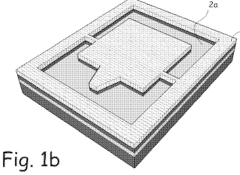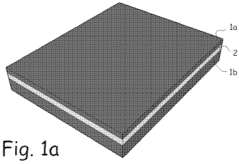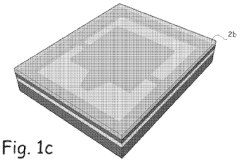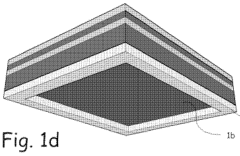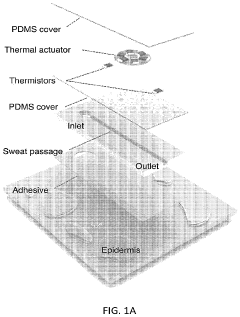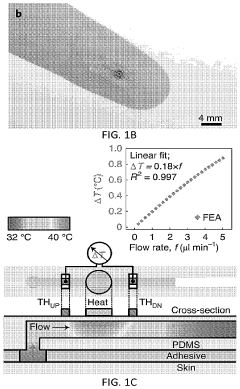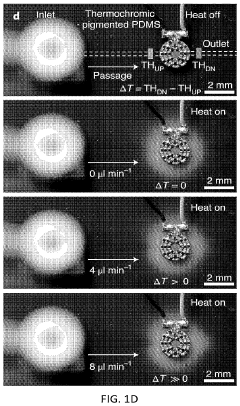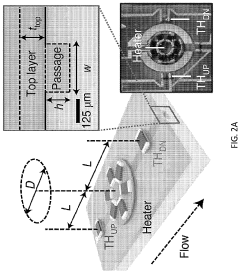How to Implement Ferrofluid in Next-Gen Sensor Technology?
JUL 9, 20259 MIN READ
Generate Your Research Report Instantly with AI Agent
Patsnap Eureka helps you evaluate technical feasibility & market potential.
Ferrofluid Sensor Tech Evolution and Objectives
Ferrofluid technology has undergone significant evolution since its inception in the 1960s, originally developed by NASA for rocket fuel manipulation in zero gravity. The journey from this initial application to its potential integration in next-generation sensor technology represents a fascinating trajectory of scientific progress and innovation.
The primary objective in implementing ferrofluid in next-gen sensor technology is to harness its unique properties to create more sensitive, versatile, and robust sensing devices. Ferrofluids, being magnetic liquids composed of nanoscale ferromagnetic particles suspended in a carrier fluid, offer a combination of fluid dynamics and magnetic responsiveness that can be exploited for various sensing applications.
One key goal is to develop sensors with enhanced sensitivity to magnetic fields, utilizing the ferrofluid's ability to respond to even minute changes in magnetic environments. This could lead to breakthroughs in areas such as geomagnetic sensing, biomagnetic measurements, and non-destructive testing in industrial settings.
Another objective is to create adaptive and reconfigurable sensors. The fluid nature of ferrofluids allows for sensors that can change shape or properties in response to external stimuli, potentially leading to sensors that can self-adjust or self-calibrate in real-time, adapting to changing environmental conditions.
Miniaturization is also a critical aim in this technological evolution. Researchers are working towards developing micro- and nano-scale ferrofluid-based sensors, which could revolutionize fields like medical diagnostics, enabling highly localized and non-invasive sensing within the human body.
Durability and reliability under extreme conditions represent another significant goal. Ferrofluids' unique properties could allow for the creation of sensors that maintain functionality in harsh environments, such as high-temperature industrial settings or space applications, where traditional sensors might fail.
The integration of ferrofluids with other emerging technologies, such as MEMS (Micro-Electro-Mechanical Systems) and flexible electronics, is also a key objective. This convergence aims to produce a new generation of smart, multifunctional sensing devices capable of measuring multiple parameters simultaneously.
As we look towards the future, the ultimate goal in ferrofluid sensor technology is to achieve a paradigm shift in how we approach sensing and measurement. The vision is to create sensors that not only detect and measure but also interact with and manipulate their environment, opening up new possibilities in fields ranging from environmental monitoring to advanced robotics and beyond.
The primary objective in implementing ferrofluid in next-gen sensor technology is to harness its unique properties to create more sensitive, versatile, and robust sensing devices. Ferrofluids, being magnetic liquids composed of nanoscale ferromagnetic particles suspended in a carrier fluid, offer a combination of fluid dynamics and magnetic responsiveness that can be exploited for various sensing applications.
One key goal is to develop sensors with enhanced sensitivity to magnetic fields, utilizing the ferrofluid's ability to respond to even minute changes in magnetic environments. This could lead to breakthroughs in areas such as geomagnetic sensing, biomagnetic measurements, and non-destructive testing in industrial settings.
Another objective is to create adaptive and reconfigurable sensors. The fluid nature of ferrofluids allows for sensors that can change shape or properties in response to external stimuli, potentially leading to sensors that can self-adjust or self-calibrate in real-time, adapting to changing environmental conditions.
Miniaturization is also a critical aim in this technological evolution. Researchers are working towards developing micro- and nano-scale ferrofluid-based sensors, which could revolutionize fields like medical diagnostics, enabling highly localized and non-invasive sensing within the human body.
Durability and reliability under extreme conditions represent another significant goal. Ferrofluids' unique properties could allow for the creation of sensors that maintain functionality in harsh environments, such as high-temperature industrial settings or space applications, where traditional sensors might fail.
The integration of ferrofluids with other emerging technologies, such as MEMS (Micro-Electro-Mechanical Systems) and flexible electronics, is also a key objective. This convergence aims to produce a new generation of smart, multifunctional sensing devices capable of measuring multiple parameters simultaneously.
As we look towards the future, the ultimate goal in ferrofluid sensor technology is to achieve a paradigm shift in how we approach sensing and measurement. The vision is to create sensors that not only detect and measure but also interact with and manipulate their environment, opening up new possibilities in fields ranging from environmental monitoring to advanced robotics and beyond.
Market Demand Analysis for Ferrofluid-Based Sensors
The market demand for ferrofluid-based sensors is experiencing significant growth, driven by advancements in nanotechnology and the increasing need for high-precision sensing solutions across various industries. Ferrofluids, which are colloidal liquids containing magnetic nanoparticles, offer unique properties that make them ideal for next-generation sensor applications.
In the automotive sector, there is a rising demand for ferrofluid-based sensors in vehicle stability control systems, adaptive suspension systems, and advanced driver assistance systems (ADAS). These sensors provide enhanced accuracy and responsiveness in detecting vehicle dynamics, contributing to improved safety and performance. The automotive industry's shift towards electric and autonomous vehicles further amplifies the need for sophisticated sensing technologies, positioning ferrofluid-based sensors as a promising solution.
The aerospace industry presents another substantial market opportunity for ferrofluid sensors. With the increasing complexity of aircraft systems and the push for more fuel-efficient designs, there is a growing demand for lightweight, high-performance sensors. Ferrofluid-based sensors can be utilized in flight control systems, engine monitoring, and structural health monitoring applications, offering improved reliability and precision over traditional sensor technologies.
In the healthcare sector, the potential applications of ferrofluid sensors are vast and rapidly expanding. There is a strong market pull for minimally invasive diagnostic tools and advanced medical imaging technologies. Ferrofluid-based sensors show promise in areas such as magnetic resonance imaging (MRI) contrast enhancement, targeted drug delivery systems, and biosensors for early disease detection. The aging global population and the increasing prevalence of chronic diseases are driving factors behind the growing demand for innovative medical sensing technologies.
The industrial automation sector represents another significant market for ferrofluid sensors. As manufacturing processes become increasingly complex and data-driven, there is a rising need for sensors that can operate in harsh environments and provide high-resolution measurements. Ferrofluid-based sensors offer advantages in applications such as vibration monitoring, pressure sensing, and flow control, contributing to improved efficiency and reliability in industrial operations.
Environmental monitoring and energy management are emerging areas where ferrofluid sensors are gaining traction. With growing concerns about climate change and resource conservation, there is an increasing demand for advanced sensing technologies to monitor air and water quality, detect pollutants, and optimize energy consumption. Ferrofluid sensors' unique properties make them well-suited for these applications, offering high sensitivity and adaptability to various environmental conditions.
In the automotive sector, there is a rising demand for ferrofluid-based sensors in vehicle stability control systems, adaptive suspension systems, and advanced driver assistance systems (ADAS). These sensors provide enhanced accuracy and responsiveness in detecting vehicle dynamics, contributing to improved safety and performance. The automotive industry's shift towards electric and autonomous vehicles further amplifies the need for sophisticated sensing technologies, positioning ferrofluid-based sensors as a promising solution.
The aerospace industry presents another substantial market opportunity for ferrofluid sensors. With the increasing complexity of aircraft systems and the push for more fuel-efficient designs, there is a growing demand for lightweight, high-performance sensors. Ferrofluid-based sensors can be utilized in flight control systems, engine monitoring, and structural health monitoring applications, offering improved reliability and precision over traditional sensor technologies.
In the healthcare sector, the potential applications of ferrofluid sensors are vast and rapidly expanding. There is a strong market pull for minimally invasive diagnostic tools and advanced medical imaging technologies. Ferrofluid-based sensors show promise in areas such as magnetic resonance imaging (MRI) contrast enhancement, targeted drug delivery systems, and biosensors for early disease detection. The aging global population and the increasing prevalence of chronic diseases are driving factors behind the growing demand for innovative medical sensing technologies.
The industrial automation sector represents another significant market for ferrofluid sensors. As manufacturing processes become increasingly complex and data-driven, there is a rising need for sensors that can operate in harsh environments and provide high-resolution measurements. Ferrofluid-based sensors offer advantages in applications such as vibration monitoring, pressure sensing, and flow control, contributing to improved efficiency and reliability in industrial operations.
Environmental monitoring and energy management are emerging areas where ferrofluid sensors are gaining traction. With growing concerns about climate change and resource conservation, there is an increasing demand for advanced sensing technologies to monitor air and water quality, detect pollutants, and optimize energy consumption. Ferrofluid sensors' unique properties make them well-suited for these applications, offering high sensitivity and adaptability to various environmental conditions.
Current Ferrofluid Sensor Challenges
The integration of ferrofluid technology into next-generation sensors presents several significant challenges that researchers and engineers must overcome. One of the primary obstacles is the long-term stability of ferrofluids in sensor applications. Over time, ferrofluids can experience particle agglomeration and sedimentation, which can lead to reduced sensitivity and inconsistent performance of the sensors. This issue is particularly pronounced in static or low-frequency applications where the fluid remains relatively motionless for extended periods.
Another critical challenge lies in the precise control and manipulation of ferrofluids within sensor devices. The complex interplay between magnetic fields, fluid dynamics, and external stimuli makes it difficult to achieve highly accurate and repeatable measurements. This complexity is further compounded when attempting to miniaturize ferrofluid-based sensors for integration into compact or wearable devices, as the reduced scale can amplify the effects of surface tension and magnetic field inhomogeneities.
The temperature sensitivity of ferrofluids also poses a significant hurdle in sensor development. Ferrofluids' magnetic and rheological properties can vary considerably with temperature changes, potentially leading to measurement inaccuracies and reduced reliability in environments with fluctuating temperatures. This temperature dependence necessitates the development of robust compensation mechanisms or temperature-stable ferrofluid formulations.
Biocompatibility and environmental concerns present additional challenges, particularly for sensors intended for medical or environmental monitoring applications. Ensuring that ferrofluids are non-toxic, non-reactive, and do not interfere with biological processes is crucial for their adoption in these sensitive fields. Moreover, the potential environmental impact of ferrofluids, should they be released, must be carefully considered and mitigated.
The manufacturing and integration of ferrofluid-based sensors also face technical hurdles. Achieving consistent quality and properties of ferrofluids at scale, as well as developing efficient methods for incorporating them into sensor devices without contamination or degradation, remain significant challenges. Additionally, the need for specialized equipment and handling procedures can increase production costs and complexity.
Lastly, the development of robust readout and signal processing techniques for ferrofluid sensors presents ongoing challenges. The non-linear behavior of ferrofluids and the potential for interference from external magnetic fields require sophisticated algorithms and hardware to extract accurate and reliable sensor data. This is particularly challenging in multi-sensor arrays or in environments with varying electromagnetic conditions.
Another critical challenge lies in the precise control and manipulation of ferrofluids within sensor devices. The complex interplay between magnetic fields, fluid dynamics, and external stimuli makes it difficult to achieve highly accurate and repeatable measurements. This complexity is further compounded when attempting to miniaturize ferrofluid-based sensors for integration into compact or wearable devices, as the reduced scale can amplify the effects of surface tension and magnetic field inhomogeneities.
The temperature sensitivity of ferrofluids also poses a significant hurdle in sensor development. Ferrofluids' magnetic and rheological properties can vary considerably with temperature changes, potentially leading to measurement inaccuracies and reduced reliability in environments with fluctuating temperatures. This temperature dependence necessitates the development of robust compensation mechanisms or temperature-stable ferrofluid formulations.
Biocompatibility and environmental concerns present additional challenges, particularly for sensors intended for medical or environmental monitoring applications. Ensuring that ferrofluids are non-toxic, non-reactive, and do not interfere with biological processes is crucial for their adoption in these sensitive fields. Moreover, the potential environmental impact of ferrofluids, should they be released, must be carefully considered and mitigated.
The manufacturing and integration of ferrofluid-based sensors also face technical hurdles. Achieving consistent quality and properties of ferrofluids at scale, as well as developing efficient methods for incorporating them into sensor devices without contamination or degradation, remain significant challenges. Additionally, the need for specialized equipment and handling procedures can increase production costs and complexity.
Lastly, the development of robust readout and signal processing techniques for ferrofluid sensors presents ongoing challenges. The non-linear behavior of ferrofluids and the potential for interference from external magnetic fields require sophisticated algorithms and hardware to extract accurate and reliable sensor data. This is particularly challenging in multi-sensor arrays or in environments with varying electromagnetic conditions.
Existing Ferrofluid Sensor Solutions
01 Composition and preparation of ferrofluids
Ferrofluids are colloidal suspensions of magnetic nanoparticles in a carrier fluid. They typically consist of magnetite or other ferromagnetic materials coated with surfactants to prevent agglomeration. The preparation process involves careful control of particle size, surfactant selection, and carrier fluid properties to achieve stable and responsive ferrofluids.- Composition and preparation of ferrofluids: Ferrofluids are colloidal suspensions of magnetic nanoparticles in a carrier fluid. They are typically composed of magnetite or other ferromagnetic materials coated with surfactants to prevent agglomeration. The preparation process involves careful control of particle size and distribution to maintain stability and magnetic properties.
- Applications in sealing and lubrication: Ferrofluids are widely used in sealing and lubrication applications, particularly in rotating shaft seals. They provide a liquid barrier that can be controlled by magnetic fields, offering advantages in terms of low friction, long life, and the ability to operate in vacuum environments.
- Thermal management and cooling systems: Ferrofluids are employed in thermal management solutions, particularly for electronic devices. Their unique properties allow for efficient heat transfer and cooling when subjected to magnetic fields, making them valuable in applications such as computer cooling systems and power electronics.
- Sensor and actuator technologies: Ferrofluids are utilized in various sensor and actuator designs. Their responsiveness to magnetic fields enables applications in accelerometers, tilt sensors, and damping systems. They can also be used in haptic feedback devices and adaptive optics systems.
- Medical and biomedical applications: Ferrofluids have potential applications in the medical field, including targeted drug delivery, magnetic hyperthermia for cancer treatment, and contrast agents for magnetic resonance imaging (MRI). Their ability to be manipulated by external magnetic fields makes them promising for minimally invasive medical procedures.
02 Applications in sealing and lubrication
Ferrofluids are widely used in sealing and lubrication applications, particularly in rotating shaft seals and bearings. Their unique properties allow them to form liquid seals that can be controlled by magnetic fields, providing effective containment of gases and liquids while reducing friction and wear in mechanical systems.Expand Specific Solutions03 Thermal management and heat transfer
Ferrofluids exhibit enhanced heat transfer properties due to their magnetic nature. They are used in cooling systems for electronic devices, transformers, and other heat-generating equipment. The ability to manipulate ferrofluids with magnetic fields allows for targeted and efficient heat removal in various applications.Expand Specific Solutions04 Sensor and actuator technologies
Ferrofluids are employed in various sensor and actuator designs, leveraging their responsiveness to magnetic fields. They are used in accelerometers, tilt sensors, and position sensors. In actuators, ferrofluids can be used to create controllable damping systems and adaptive structures for vibration control and precision positioning.Expand Specific Solutions05 Medical and biomedical applications
Ferrofluids have emerging applications in medicine and biotechnology. They are being researched for targeted drug delivery, magnetic hyperthermia for cancer treatment, and as contrast agents in magnetic resonance imaging (MRI). The ability to manipulate ferrofluids externally using magnetic fields offers potential for minimally invasive medical procedures and diagnostics.Expand Specific Solutions
Key Players in Ferrofluid Sensor Industry
The implementation of ferrofluid in next-generation sensor technology is in an early development stage, with a growing market potential due to its unique properties. The technology's maturity is still evolving, with key players from academia and industry driving innovation. Universities like Chongqing University, Northwestern University, and Tsinghua University are conducting fundamental research, while companies such as Honeywell International Technologies Ltd. and STMicroelectronics International NV are exploring practical applications. The competitive landscape is diverse, with collaborations between research institutions and industry leaders shaping the field's progress. As the technology advances, we can expect increased market interest and potential breakthroughs in sensor miniaturization, sensitivity, and adaptability across various industries.
Honeywell International Technologies Ltd.
Technical Solution: Honeywell has developed a ferrofluid-based sensor technology that utilizes the unique properties of magnetic nanoparticles suspended in a carrier fluid. Their approach involves creating a thin film of ferrofluid that changes its physical properties in response to external stimuli such as magnetic fields, temperature, or pressure. The sensor design incorporates microfluidic channels and high-precision electromagnetic coils to manipulate and detect changes in the ferrofluid's behavior. This allows for highly sensitive and accurate measurements of various parameters in industrial and aerospace applications[1][3]. The technology also includes advanced signal processing algorithms to filter out noise and enhance the sensor's performance in challenging environments[5].
Strengths: High sensitivity, multi-parameter sensing capability, and robustness in harsh environments. Weaknesses: Potential for magnetic particle agglomeration over time, and the need for periodic recalibration.
Koninklijke Philips NV
Technical Solution: Philips has innovated in ferrofluid sensor technology by developing a novel approach that combines ferrofluids with optical sensing methods. Their system uses a transparent microfluidic chip containing ferrofluid droplets. When exposed to external stimuli, the ferrofluid droplets deform, causing changes in light transmission or reflection. These changes are detected by high-resolution optical sensors and analyzed using machine learning algorithms to determine the nature and magnitude of the stimuli[2][4]. The technology is particularly suited for medical diagnostics and environmental monitoring, offering non-invasive and highly accurate sensing capabilities. Philips has also incorporated wireless connectivity features, allowing for real-time data transmission and remote monitoring[6].
Strengths: Non-invasive sensing, high accuracy, and potential for miniaturization. Weaknesses: Complexity of optical components and potential light interference in certain environments.
Core Ferrofluid Sensor Innovations
Tubular multifunction sensor in fluids method for production and use thereof
PatentWO2009100988A2
Innovation
- A method for manufacturing tubular multifunction sensors using ferromagnetic micro/nano-tubes with controlled dimensions and magnetic content, which can be precisely positioned and used as single portable sensors in liquids, avoiding contamination by applying an external magnetic field to measure rotational dynamics.
Systems and methods for wireless, real-time monitoring parameters of sweat and applications of same
PatentActiveUS20230270372A1
Innovation
- A miniaturized, wireless electronic system that uses a thermal sensing module with a Bluetooth Low Energy (BLE) system on a chip for non-contact measurement of sweat rate, combining a power-efficient thermal actuator and precision thermistors with a BLE SoC for real-time data transfer, and integrates with advanced microfluidic systems for colorimetric chemical analysis, allowing for continuous monitoring of sweat rate, loss, and temperature without direct contact with sweat.
Environmental Impact of Ferrofluid Sensors
The implementation of ferrofluid in next-generation sensor technology brings forth significant environmental considerations that must be carefully evaluated. Ferrofluids, composed of nanoscale magnetic particles suspended in a carrier fluid, possess unique properties that make them valuable for sensing applications. However, their potential environmental impact requires thorough assessment.
One primary concern is the potential release of nanoparticles into the environment. While ferrofluids are typically contained within sealed systems, the risk of leakage or improper disposal exists. These nanoparticles, often made of iron oxide, could potentially accumulate in soil and water systems. Their small size allows them to interact with biological systems in ways that larger particles cannot, potentially affecting microorganisms and entering food chains.
The production process of ferrofluids also warrants attention from an environmental perspective. The synthesis of magnetic nanoparticles often involves chemical processes that may generate waste products. Ensuring proper handling and disposal of these byproducts is crucial to minimize environmental contamination. Additionally, the energy consumption associated with ferrofluid production and the sourcing of raw materials contribute to the overall environmental footprint of these sensors.
On the positive side, ferrofluid-based sensors have the potential to enhance environmental monitoring capabilities. Their high sensitivity and versatility could lead to more accurate and efficient detection of pollutants, oil spills, or other environmental hazards. This improved monitoring could contribute to faster response times and more effective environmental protection measures.
The longevity and recyclability of ferrofluid sensors are also important factors to consider. If designed for durability and easy disassembly, these sensors could have extended lifespans, reducing the frequency of replacement and associated waste. Furthermore, developing effective recycling processes for ferrofluid sensors could help recover valuable materials and minimize the environmental impact of disposal.
As with any emerging technology, the environmental impact of ferrofluid sensors must be evaluated throughout their entire lifecycle. This includes assessing the sustainability of raw material extraction, manufacturing processes, operational energy consumption, and end-of-life disposal or recycling. Conducting comprehensive life cycle assessments (LCAs) will be crucial in understanding and mitigating the overall environmental impact of these sensors.
Regulatory frameworks and industry standards will play a vital role in ensuring the responsible development and deployment of ferrofluid-based sensor technology. Establishing guidelines for the safe handling, use, and disposal of ferrofluids in sensor applications will be essential to protect both human health and the environment. Collaboration between researchers, industry stakeholders, and environmental agencies will be necessary to develop and implement these standards effectively.
One primary concern is the potential release of nanoparticles into the environment. While ferrofluids are typically contained within sealed systems, the risk of leakage or improper disposal exists. These nanoparticles, often made of iron oxide, could potentially accumulate in soil and water systems. Their small size allows them to interact with biological systems in ways that larger particles cannot, potentially affecting microorganisms and entering food chains.
The production process of ferrofluids also warrants attention from an environmental perspective. The synthesis of magnetic nanoparticles often involves chemical processes that may generate waste products. Ensuring proper handling and disposal of these byproducts is crucial to minimize environmental contamination. Additionally, the energy consumption associated with ferrofluid production and the sourcing of raw materials contribute to the overall environmental footprint of these sensors.
On the positive side, ferrofluid-based sensors have the potential to enhance environmental monitoring capabilities. Their high sensitivity and versatility could lead to more accurate and efficient detection of pollutants, oil spills, or other environmental hazards. This improved monitoring could contribute to faster response times and more effective environmental protection measures.
The longevity and recyclability of ferrofluid sensors are also important factors to consider. If designed for durability and easy disassembly, these sensors could have extended lifespans, reducing the frequency of replacement and associated waste. Furthermore, developing effective recycling processes for ferrofluid sensors could help recover valuable materials and minimize the environmental impact of disposal.
As with any emerging technology, the environmental impact of ferrofluid sensors must be evaluated throughout their entire lifecycle. This includes assessing the sustainability of raw material extraction, manufacturing processes, operational energy consumption, and end-of-life disposal or recycling. Conducting comprehensive life cycle assessments (LCAs) will be crucial in understanding and mitigating the overall environmental impact of these sensors.
Regulatory frameworks and industry standards will play a vital role in ensuring the responsible development and deployment of ferrofluid-based sensor technology. Establishing guidelines for the safe handling, use, and disposal of ferrofluids in sensor applications will be essential to protect both human health and the environment. Collaboration between researchers, industry stakeholders, and environmental agencies will be necessary to develop and implement these standards effectively.
Ferrofluid Sensor Standardization
The standardization of ferrofluid sensors is a critical step in advancing their implementation in next-generation sensor technology. This process involves establishing uniform guidelines, protocols, and specifications for the development, manufacturing, and testing of ferrofluid-based sensors. Standardization ensures consistency, reliability, and interoperability across different sensor systems and applications.
One key aspect of ferrofluid sensor standardization is the development of reference materials and calibration methods. These standards help ensure accurate and reproducible measurements across different sensor units and manufacturers. Establishing standardized ferrofluid compositions with known magnetic properties and viscosities is essential for creating reliable benchmarks.
Standardization efforts also focus on defining performance metrics and testing procedures for ferrofluid sensors. This includes specifying parameters such as sensitivity, response time, dynamic range, and environmental stability. By creating standardized test protocols, researchers and manufacturers can objectively compare different sensor designs and evaluate their suitability for specific applications.
Another important area of standardization is the development of interface protocols and data formats for ferrofluid sensors. This ensures seamless integration of these sensors into larger systems and facilitates data exchange between different devices and platforms. Standardized communication protocols enable interoperability and simplify the incorporation of ferrofluid sensors into existing sensor networks.
Safety and environmental considerations are also addressed in the standardization process. Guidelines for the safe handling, storage, and disposal of ferrofluids used in sensors are established to minimize potential risks and environmental impact. These standards help ensure compliance with regulations and promote responsible use of ferrofluid technology.
Standardization efforts extend to the manufacturing processes of ferrofluid sensors as well. This includes defining quality control measures, tolerance levels, and production techniques to ensure consistent sensor performance and reliability. Standardized manufacturing practices help reduce variability between sensor units and improve overall product quality.
Collaboration between industry stakeholders, research institutions, and regulatory bodies is crucial for successful ferrofluid sensor standardization. International organizations such as ISO (International Organization for Standardization) and IEEE (Institute of Electrical and Electronics Engineers) play a vital role in coordinating these efforts and developing globally recognized standards.
As ferrofluid sensor technology continues to evolve, standardization efforts must remain dynamic and adaptable. Regular reviews and updates of standards are necessary to keep pace with technological advancements and emerging applications. This ongoing process ensures that standardization supports rather than hinders innovation in the field of ferrofluid-based sensors.
One key aspect of ferrofluid sensor standardization is the development of reference materials and calibration methods. These standards help ensure accurate and reproducible measurements across different sensor units and manufacturers. Establishing standardized ferrofluid compositions with known magnetic properties and viscosities is essential for creating reliable benchmarks.
Standardization efforts also focus on defining performance metrics and testing procedures for ferrofluid sensors. This includes specifying parameters such as sensitivity, response time, dynamic range, and environmental stability. By creating standardized test protocols, researchers and manufacturers can objectively compare different sensor designs and evaluate their suitability for specific applications.
Another important area of standardization is the development of interface protocols and data formats for ferrofluid sensors. This ensures seamless integration of these sensors into larger systems and facilitates data exchange between different devices and platforms. Standardized communication protocols enable interoperability and simplify the incorporation of ferrofluid sensors into existing sensor networks.
Safety and environmental considerations are also addressed in the standardization process. Guidelines for the safe handling, storage, and disposal of ferrofluids used in sensors are established to minimize potential risks and environmental impact. These standards help ensure compliance with regulations and promote responsible use of ferrofluid technology.
Standardization efforts extend to the manufacturing processes of ferrofluid sensors as well. This includes defining quality control measures, tolerance levels, and production techniques to ensure consistent sensor performance and reliability. Standardized manufacturing practices help reduce variability between sensor units and improve overall product quality.
Collaboration between industry stakeholders, research institutions, and regulatory bodies is crucial for successful ferrofluid sensor standardization. International organizations such as ISO (International Organization for Standardization) and IEEE (Institute of Electrical and Electronics Engineers) play a vital role in coordinating these efforts and developing globally recognized standards.
As ferrofluid sensor technology continues to evolve, standardization efforts must remain dynamic and adaptable. Regular reviews and updates of standards are necessary to keep pace with technological advancements and emerging applications. This ongoing process ensures that standardization supports rather than hinders innovation in the field of ferrofluid-based sensors.
Unlock deeper insights with Patsnap Eureka Quick Research — get a full tech report to explore trends and direct your research. Try now!
Generate Your Research Report Instantly with AI Agent
Supercharge your innovation with Patsnap Eureka AI Agent Platform!
